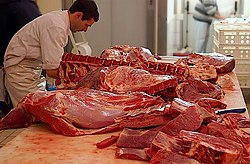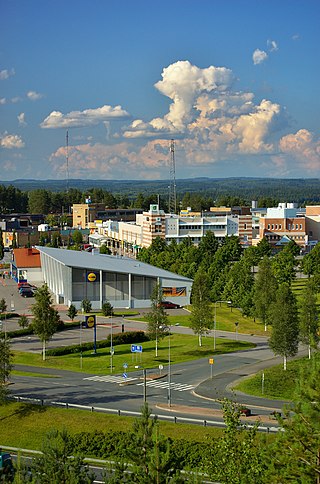
A supermarket is a self-service shop offering a wide variety of food, beverages and household products, organized into sections. This kind of store is larger and has a wider selection than earlier grocery stores, but is smaller and more limited in the range of merchandise than a hypermarket or big-box market. In everyday U.S. usage, however, "grocery store" is often used to mean "supermarket".

A beefsteak, often called just steak, is a flat cut of beef with parallel faces, usually cut perpendicular to the muscle fibers. In common restaurant service a single serving has a raw mass ranging from 120 to 600 grams. Beef steaks are usually grilled, pan-fried, or broiled. The more tender cuts from the loin and rib are cooked quickly, using dry heat, and served whole. Less tender cuts from the chuck or round are cooked with moist heat or are mechanically tenderized.

Lamb, hogget, and mutton, generically sheep meat, are the meat of domestic sheep, Ovis aries. A sheep in its first year is a lamb and its meat is also lamb. The meat from sheep in their second year is hogget. Older sheep meat is mutton. Generally, "hogget" and "sheep meat" are not used by consumers outside Norway, New Zealand, South Africa, Scotland, and Australia. Hogget has become more common in England, particularly in the North often in association with rare breed and organic farming.

A grocery store (AE), grocery shop (BE) or simply grocery is a foodservice retail store that primarily retails a general range of food products, which may be fresh or packaged. In everyday U.S. usage, however, "grocery store" is a synonym for supermarket, and is not used to refer to other types of stores that sell groceries. In the UK, shops that sell food are distinguished as grocers or grocery shops.
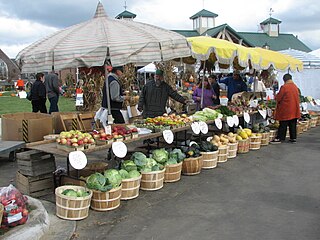
A farmers' market is a physical retail marketplace intended to sell foods directly by farmers to consumers. Farmers' markets may be indoors or outdoors and typically consist of booths, tables or stands where farmers sell their produce, live animals and plants, and sometimes prepared foods and beverages. Farmers' markets exist in many countries worldwide and reflect the local culture and economy. The size of the market may be just a few stalls or it may be as large as several city blocks. Due to their nature, they tend to be less rigidly regulated than retail produce shops.

A butcher is a person who may slaughter animals, dress their flesh, sell their meat, or participate within any combination of these three tasks. They may prepare standard cuts of meat and poultry for sale in retail or wholesale food establishments. A butcher may be employed by supermarkets, grocery stores, butcher shops and fish markets, slaughter houses, or may be self-employed.

Beef aging or ageing is a process of preparing beef for consumption by aging it, in order to break down the connective tissue within the meat.

A beef tenderloin, known as an eye fillet in Australasia, filet in France, filé mignon in Brazil, and fillet in the United Kingdom and South Africa, is cut from the loin of beef.
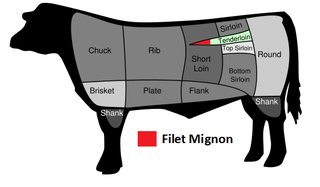
Filet mignon is a cut of meat taken from the smaller end of the tenderloin, or psoas major of a cow. In French, it mostly refers to cuts of pork tenderloin.
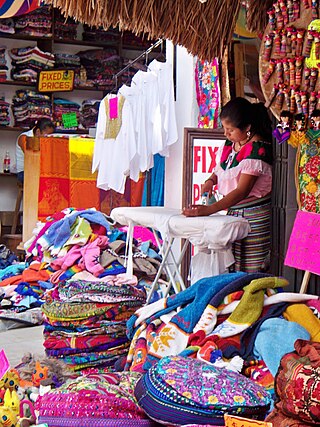
A shopkeeper is a retail merchant or tradesman; one who owns or operates a small store or shop. Generally, shop employees are not shopkeepers, but are often incorrectly referred to as such. At larger companies, a shopkeeper is usually referred to as a manager, since the owner is not able to manage the business being a single shopkeeper, so this term could apply to larger firms generally and be a separate duty.

A wet market is a marketplace selling fresh foods such as meat, fish, produce and other consumption-oriented perishable goods in a non-supermarket setting, as distinguished from "dry markets" that sell durable goods such as fabrics, kitchenwares and electronics. These include a wide variety of markets, such as farmers' markets, fish markets, and wildlife markets. Not all wet markets sell live animals, but the term wet market is sometimes used to signify a live animal market in which vendors slaughter animals upon customer purchase, such as is done with poultry in Hong Kong. Wet markets are common in many parts of the world, notably in China, Southeast Asia, and South Asia. They often play critical roles in urban food security due to factors of pricing, freshness of food, social interaction, and local cultures.

A meat market is, traditionally, a marketplace where meat is sold, often by a butcher. It is a specialized wet market. The term is sometimes used to refer to a meat retail store or butcher's shop, in particular in North America. During the mid and late 19th century scientific research into epidemiology, sanitation and urban planning in Western countries led to the establishment of meat markets so that the slaughtering and sale of meat could be easily monitored and the risk of disease outbreaks could be minimized.

A primal cut or cut of meat is a piece of meat initially separated from the carcass of an animal during butchering. Examples of primals include the round, loin, rib, and chuck for beef or the ham, loin, Boston butt, and picnic for pork.
Mac Fisheries was a branded United Kingdom retail chain of fishmongers, founded by William Lever, 1st Viscount Leverhulme, the co-founder with his brother of Lever Brothers, which later merged to become Unilever.

Dressed weight refers to the weight of an animal after being partially butchered, removing all the internal organs and often the head as well as inedible portions of the tail and legs. It includes the bones, cartilage and other body structure still attached after this initial butchering. It is usually a fraction of the total weight of the animal, and an average of 59% of the original weight for cattle. There is no singular way to dress an animal, as what is removed depends on whether it will be cooked whole or butchered further for sale of individual parts. For pigs, the dressed weight typically includes the skin, while most other ungulates are typically dressed without. For fowl, it is calculated with skin but without feathers. It can be expressed as a percentage of the animal's live weight, when it is known as the killing out percentage.
Countries regulate the marketing and sale of beef by observing criteria of cattle carcasses at the abattoir (slaughterhouse) and classifying the carcasses. This classification, sometimes optional, can suggest a market demand for a particular animal's attributes and therefore the price owed to the producer.

Case-ready meat, retail-ready meat, or pre-packaged meat refers to fresh meat that is processed and packaged at a central facility and delivered to the store ready to be put directly into the meat case.

Crocodile skin either refers to the skin of a live crocodile or a leather made from dead crocodile hide. It has multiple applications across the fashion industry such as use for bags, shoes, and upholstery after being farmed and treated in specialist farms and tanneries.
The Butcher is an American competition reality series that airs on the History channel. In each episode, four butchers compete in a three-round elimination contest to test their butchering skills, with the overall winner receiving $10,000 and the day's championship title. The series is hosted by Colby Donaldson, with a three-judge panel consisting of David Budworth, Roxanne Spruance, and Michael Sullivan, experts in the practice of butchering. The series premiered on May 22, 2019, with a six-episode first season. The series shares a similar format to its sister-show Forged in Fire.
The retail format influences the consumer's store choice and addresses the consumer's expectations. At its most basic level, a retail format is a simple marketplace, that is; a location where goods and services are exchanged. In some parts of the world, the retail sector is still dominated by small family-run stores, but large retail chains are increasingly dominating the sector, because they can exert considerable buying power and pass on the savings in the form of lower prices. Many of these large retail chains also produce their own private labels which compete alongside manufacturer brands. Considerable consolidation of retail stores has changed the retail landscape, transferring power away from wholesalers and into the hands of the large retail chains.
